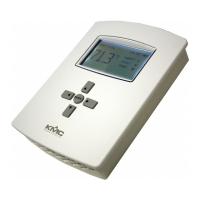BAC-1xx63/1xxx63 Series (6 Relays and 3 Analog Outputs) Section 32 Application Guide L
The heating/cooling mode can also be manually set by adjusting the
“System Mode” through the user interface. The System Mode can be set
to Auto, Heat, Cool and O. On the heat pump application, the System
Mode can also be set to Emergency Heat. If the System Mode is set to
Auto, the FlexStat will automatically determine the heating or cooling
mode as described above. Seing the System Mode to “Heat” or “Cool”
(or Emer Ht) forces the unit into that mode. Seing the System Mode to
“O” turns o all heating and cooling functions but has no eect on fan
control.
Occupancy Modes
Occupied mode is normally determined by the weekly schedule. It is
used for determining which space temperature setpoints to use, whether
to run the fan in constant or intermient mode and whether to ventilate
(outside air damper minimum position) or not.
In addition to temporarily placing the controller into the occupied
mode if it is not already in occupied mode, occupancy override is used
to temporarily override the space temperature setpoints for a prede-
termined period of time. As such, occupancy override may be activated
during either occupied mode or unoccupied mode. This is done by
either changing the setpoint via the Up/Down buons from the home
screen of the FlexStat or starting the override mode from the override
menu (Le and then Enter buons on the OCC icon of the home screen).
Additionally, on models with the motion/occupancy sensor option, oc-
cupancy override may be activated via motion detected by the motion
sensor if the Occupancy Override Sensor option is enabled. This option
will only activate occupancy override during the unoccupied mode.
Once activated, the occupancy override mode functions in one of two
ways, depending on conguration. Aer initial activation (if the occu-
pancy override timer is set to a non-zero value), the occupancy override
mode will turn itself o aer the period of time set by the timer expires.
Alternately, it will turn o at the next schedule change if that comes rst.
If the override timer value is set to zero, the schedule state (occupied or
unoccupied) is logged just prior to the activation of the override mode.
Once activated in this zero timer mode, the occupancy override will
expire upon the next normal scheduled change of state of the scheduled
occupied mode. The following two examples illustrate this operation.
For both examples, assume the override timer is set to zero and the
scheduled occupied mode is on at 8:00 AM and o at 5:00 PM:
• Example 1. The override mode is activated at 4:57 PM. The occu-
pancy override starts at 4:57 PM and expires at 5:00 PM.
• Example 2. The override mode is activated at 5:01 PM. The oc-
cupancy override starts at 5:01 PM and expires at 8:00 AM the
following morning.
How the override mode aects temperature setpoints depends on how
the mode was initiated:
If the mode was initiated from entering on the occupancy icon on the
home screen, the FlexStat will maintain the normal occupied heating and
occupied cooling setpoints until the expiration of the override mode.
If the override mode was initiated by modifying the setpoint via the up/
down buons of the home screen on the user interface, then the active
setpoint of the current heating or cooling mode is adjusted according
to the buons. The complimentary active setpoint (i.e., cooling, if the
FlexStat is presently in the heating mode) is then set to the minimum
setpoint dierential away from the present mode active setpoint (limits
allowing). The FlexStat will aempt to maintain the space temp set-
point as entered at the start of the occupied override mode. However,
minimum setpoint dierential and occupied heating max and occupied
cooling min limits still apply to override mode setpoint adjustments and
operations.
If, during occupancy override mode via setpoint adjust, the unit is in
heating mode and the temperature passes the active cooling setpoint, the
active mode becomes cooling. The active cooling setpoint then becomes
the old active heating setpoint and the active heating setpoint is lowered
by the minimum setpoint dierential. Again, occupied heating max and
occupied cooling min limits still apply. Similar setpoint swapping occurs
if the unit was in the cooling mode and the temperature falls below the
active heating setpoint.
The FlexStat is considered in the “occupied” mode whether it is set by
normal schedule operation or occupied override mode. If the FlexStat is
not scheduled on or in the occupancy override mode, it is considered in
“unoccupied” state.

